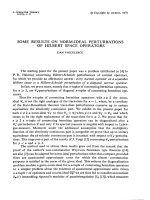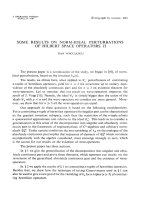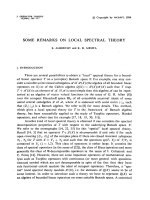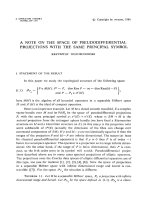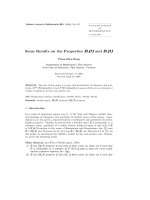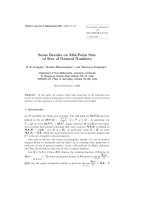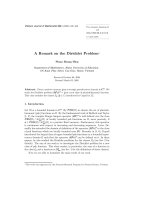Báo cáo toán học: "Some remarks on the Plotkin bound" doc
Bạn đang xem bản rút gọn của tài liệu. Xem và tải ngay bản đầy đủ của tài liệu tại đây (101.59 KB, 8 trang )
Some remarks on the Plotkin bound
J¨orn Quistorff
Speckenreye 48
22119 Hamburg, Germany
Submitted: Nov 24, 2001; Accepted: Jun 17, 2003; Published: Jun 27, 2003
MR Subject Classifications: 94B65
Abstract
In coding theory, Plotkin’s upper bound on the maximal cadinality of a code with
minimum distance at least d is well known. He presented it for binary codes where
Hamming and Lee metric coincide. After a brief discussion of the generalization
to q-ary codes preserved with the Hamming metric, the application of the Plotkin
bound to q-ary codes preserved with the Lee metric due to Wyner and Graham is
improved.
1 Introduction
Let K be a set of cardinality q ∈ N and d
K
: K ×K → R be a metric. Consider R := K
n
with n ∈ N and d
R
((v
1
, , v
n
), (w
1
, , w
n
)) :=
n
i=1
d
K
(v
i
,w
i
). Then (K, d
K
)and(R, d
R
)
are finite metric spaces.
A subset C ⊆ R is called a (block) code of length n.If|C|≥2 then its minimum
distance is defined by d(C):=min{d
R
(v, w) ∈ R
+
|v, w ∈ C and v = w}. The observation
of the metric properties of (R, d
R
) and of its subsets is an essential part of coding theory.
The value u(R, d
R
,d) (or briefly u(d )), defined as the maximal cardinality of a code C ⊆ R
with minimum distance d(C) ≥ d, is frequently considered.
The determination of u(d) is a fundamental and often unsolved problem but some
lower and upper bounds are well known. This paper deals with the following condition on
the parameters of a code which gives Plotkin’s upper bound on u(d). Similar formulations
are given by Berlekamp [1] and Rˇaduicˇa[8].
Let d>0andu ∈ N \{1} .PutJ := {0, , u − 1}.Ifu(d) ≥ u then
d
u
2
≤ n max
{j,k}⊆J
d
K
(v
(j)
1
,v
(k)
1
)|(v
(0)
1
, , v
(u−1)
1
) ∈ K
u
=: nP
(K,d
K
)
(u). (1)
This condition is easy to prove by estimating
{v,w}⊆C
d
R
(v, w).
the electronic journal of combinatorics 10 (2003), #N6 1
If instead of P
(K,d
K
)
(u) an upper bound Q
(K,d
K
)
(u) is known then inequality (1) can
be replaced by
d
u
2
≤ nQ
(K,d
K
)
(u). (2)
The most common finite metric spaces in coding theory are the (n-dimensional q-ary)
Hamming spaces (R, d
H
). Here, the Hamming metric can be introduced by
d
H
((v
1
, , v
n
), (w
1
, , w
n
)) =
n
i=1
d
H
(v
i
,w
i
)
and
d
H
(v
i
,w
i
)=
0ifv
i
= w
i
1ifv
i
= w
i
.
Furthermore, A
q
(n, d) is usually used instead of u(R, d
H
,d).
Other common finite metric spaces in coding theory consider R = K
n
with K = Z/qZ
together with the Lee metric d
L
which can be introduced by
d
L
((v
1
, , v
n
), (w
1
, , w
n
)) =
n
i=1
d
L
(v
i
,w
i
)
and
d
L
(v
i
,w
i
)=min{|v
i
− w
i
|,q−|v
i
− w
i
|}. (3)
Whenever, like on the right-hand side of equation (3), an order ≤ is used in Z/pZ,their
elements have to be represented by elements of {0, , p − 1}⊆Z. The spaces (R, d
L
)
should be called Lee spaces.
In case of q ≤ 3, the metrics d
H
and d
L
are identical. Lee [3] noticed that also the
case ((Z/4Z)
n
,d
L
) can be reduced to ((Z/2Z)
2n
,d
H
), using the transformation 0 → (0, 0),
1 → (0, 1), 2 → (1, 1), 3 → (1, 0). The pathological case q = 1 is usually omitted.
After a brief discussion of the Plotkin bound in Hamming spaces, the paper considers
this bound in Lee spaces.
2 Hamming Spaces
Plotkin [6] introduced his bound in case of q = 2 where Hamming and Lee metric coincide.
In terms of condition (1), he used P
H
2
(u):=P
({0,1},d
H
)
(u)=
u+1
2
(u −
u+1
2
) and proved
the existence of an m ∈ N with
A
2
(n, d) ≤ 2m ≤
2d
2d − n
(4)
if 2d>n. MacWilliams/Sloane [5] mentioned in this case the equivalent bound
A
2
(n, d) ≤ 2
d
2d − n
. (5)
the electronic journal of combinatorics 10 (2003), #N6 2
Berlekamp [1] considered the generalization to q-ary Hamming spaces. In terms of
P
H
q
:= P
(Z/qZ,d
H
)
and Q
H
q
,heshowedP
H
q
(u) ≤ Q
H
q
(u)=
u
2
(q −1)
2q
. This result yields the
bound
A
q
(n, d) ≤
dq
dq − n(q − 1)
if dq > n(q − 1).
Quistorff [7] determined
P
H
q
(u)=
u
2
− b
a +1
2
− (q − b)
a
2
(6)
if u = aq + b with a, b ∈ N
0
and b<q. An equivalent statement can be found in
Bogdanova et al. [2]. The results (1) and (6) imply e.g. the tight upper bound A
3
(9, 7) ≤ 6.
Vaessens/Aarts/Van Lint [9] formerly mentioned this and similar examples for q =3as
an implication of Plotkin [6] and also solved the case a = b = 1 in (6) with arbitrary
q ∈ N \{1}. Mackenzie/Seberry’s [4] bound on A
3
(n, d)with3d>2n is incorrect. The
adequate use of their method leads to
A
3
(n, d) ≤ max
3
d
3d − 2n
, 3
d
3d − 2n
−
2
3
+1
if 3d>2n
which is equivalent to the application of (6).
3 Lee Spaces
Put P
L
q
(u):=P
(Z/qZ,d
L
)
(u). Wyner/Graham [10] proved
P
L
q
(u) ≤ Q
L
q
(u):=
u
2
(q
2
−1)
8q
if q is odd
u
2
8
q if q is even
as an application of the Plotkin bound in Lee spaces, cf. also Berlekamp [1]. The stronger
inequality
P
L
q
(u) ≤
Q
L
q
(u)
(7)
follows by definition. In order to improve formula (7), some preparation is necessary.
Lemma 1 Let q, u ∈ N \{1} and m ∈{1, , u − 1}.LetJ := Z/uZ and v
(j)
∈ Z/qZ
with j ∈ J and v
(j)
≤ v
(k)
for j<k. Then
j∈J
d
L
(v
(j)
,v
(j+m)
) ≤ mq (8)
and equality holds in estimation (8) iff
d
L
(v
(j)
,v
(j+m)
)=
v
(j+m)
− v
(j)
if j<u− m
q + v
(j+m)
− v
(j)
if j ≥ u − m
(9)
is valid.
the electronic journal of combinatorics 10 (2003), #N6 3
Proof:
j∈J
d
L
(v
(j)
,v
(j+1)
) ≤ q + v
(0)
− v
(u−1)
+
j∈J\{u−1}
v
(j+1)
− v
(j)
= q
and hence
j∈J
d
L
(v
(j)
,v
(j+m)
) ≤
j∈J
m−1
l=0
d
L
(v
(j+l)
,v
(j+l+1)
)
≤
m−1
l=0
j∈J
d
L
(v
(j)
,v
(j+1)
)
≤ mq.
All estimates turn out to be equalities iff condition (9) is valid. ✷
Put
N
L
q
(u):=
u
2
−1
8
q if u is odd
u(u−2)
8
q +
u
2
q
2
if u is even
with u ∈ N \{1}. Clearly,
u
2
−1
8
∈ N if u is odd and
u(u−2)
8
∈ N
0
if u is even.
Theorem 2 Let q, u ∈ N \{1}. Then P
L
q
(u) ≤ N
L
q
(u) holds true.
Proof: Let v
(j)
∈ Z/qZ with j ∈ J := Z/uZ. Without loss of generality, let v
(j)
≤ v
(k)
for
j<k.
(i) Let u be odd. Then
{j,k}⊆J
d
L
(v
(j)
,v
(k)
)=
u−1
2
m=1
j∈J
d
L
(v
(j)
,v
(j+m)
)
≤
u−1
2
m=1
mq = N
L
q
(u)
follows by Lemma 1.
(ii) Let u be even. Then
{j,k}⊆J
d
L
(v
(j)
,v
(k)
)=
u
2
−1
m=1
j∈J
d
L
(v
(j)
,v
(j+m)
)+
j∈J;j<
u
2
d
L
(v
(j)
,v
(j+
u
2
)
)
≤
u
2
−1
m=1
mq +
u
2
q
2
= N
L
q
(u)
follows by Lemma 1.
the electronic journal of combinatorics 10 (2003), #N6 4
Hence, in both cases P
L
q
(u) ≤ N
L
q
(u) is valid. ✷
Theorem 2 improves formula (7) in many cases. E.g. N
L
8
(3) = 8 < 9=Q
L
8
(3) and
N
L
9
(6) = 39 < 40 = Q
L
9
(6) hold true.
The following statements will prove coincidence between P
L
q
(u)andN
L
q
(u)ifq is odd
or u is small, relative to q.Putf(u):=1ifu is odd and f(u):=2ifu is even.
Lemma 3 Let q, u ∈ N \{1}.Letq be even or f(u)q ≥ u − 1.Let
jq
u
,
kq
u
∈Z/qZ
with j, k := j + m ∈ Z/uZ and 1 ≤ m ≤
u−1
2
as well as 0 ≤ j, k < u.Put
kq
u
:=
kq
u
if j<u− m
q +
kq
u
if j ≥ u − m.
Then d
L
(
jq
u
,
kq
u
)=
kq
u
−
jq
u
≤
q
2
is valid.
Proof: It holds true that
kq
u
≤
(j+
u−1
2
)q
u
and
jq
u
≥
jq−(u−1)
u
.
(i) Let u be odd. Then
kq
u
−
jq
u
≤
u−1
2
q+(u−1)
u
= (
q
2
+ 1)(1 −
1
u
).Ifq is even then
kq
u
−
jq
u
≤
q
2
.Ifq ≥ u−1then
kq
u
−
jq
u
≤(
q
2
+1)
q
q+1
=
q+1
2
−
1
2(q+1)
≤
q
2
.
(ii) Let u be even. Then
kq
u
−
jq
u
≤
(
u
2
−1)q+(u−1)
u
= (
q
2
+1)−
q+1
u
.Ifq is even
then
kq
u
−
jq
u
≤
q
2
.If2q ≥ u − 1then
kq
u
−
jq
u
≤
q+1
2
−
2(q+1)−u
2u
≤
q
2
.
Hence, d
L
(
jq
u
,
kq
u
)=
kq
u
−
jq
u
. ✷
In case of q =3,u =5,j =3,m = 2, Lemma 3 can not be applied. Here, k =0,
jq
u
=1,
kq
u
=0,
kq
u
=3,
kq
u
−
jq
u
=2> 1=
q
2
and d
L
(
jq
u
,
kq
u
)=1. Asimilar
example is q =3,u =8,j =5,m =3.
Lemma 4 Let q, u ∈ N \{1} and u be even. Let
jq
u
,
kq
u
∈Z/qZ with j, k := j +
u
2
∈
Z/uZ and 0 ≤ j<
u
2
≤ k<u. Then d
L
(
jq
u
,
kq
u
)=
q
2
is valid.
Proof: It holds true that
(j+
u
2
)q −(u−1)
u
≤
kq
u
≤
(j+
u
2
)q
u
and
jq−(u−1)
u
≤
jq
u
≤
jq
u
. Hence,
kq
u
−
jq
u
≤
q
2
+
u−1
u
≤
q+1
2
and q −
kq
u
+
jq
u
≤
q
2
+
u−1
u
≤
q+1
2
. This yields
d
L
(
jq
u
,
kq
u
)=
q
2
. ✷
Theorem 5 Let q, u ∈ N \{1}.Letq be even or f(u)q ≥ u − 1. Then P
L
q
(u)=N
L
q
(u).
Proof: Put v
(j)
:=
jq
u
for j ∈ J := Z/uZ with 0 ≤ j<u.
the electronic journal of combinatorics 10 (2003), #N6 5
(i) Let u be odd. Then
P
L
q
(u) ≥
{j,k}⊆J
d
L
(v
(j)
,v
(k)
)=
u−1
2
m=1
j∈J
d
L
(v
(j)
,v
(j+m)
)
=
u−1
2
m=1
mq
= N
L
q
(u)
by Lemma 1 and 3.
(ii) Let u be even. Then
P
L
q
(u) ≥
{j,k}⊆J
d
L
(v
(j)
,v
(k)
)
=
u
2
−1
m=1
j∈J
d
L
(v
(j)
,v
(j+m)
)+
j∈J;j<
u
2
d
L
(v
(j)
,v
(j+
u
2
)
)
= N
L
q
(u)
by Lemma 1, 3 and 4.
Theorem 2 completes the proof. ✷
If u is considerable greater than q, the Plotkin bound is usually weak and other well
known upper bounds, e.g. the Hamming bound, give stronger results. Hence, it seems
not to be fatal that P
L
q
(u) is not determined in all these cases. The final theorem gives
at least a lower bound on P
L
q
(u). According to Theorem 5, it is sufficent to consider only
odd values of q. The following convention is used. Extending inequality (1) by u ∈{0, 1},
one gets P
(K,d
K
)
(u) = 0 and hence P
L
q
(0) = P
L
q
(1) = 0.
Theorem 6 Let q, u ∈ N \{1} and q be odd. Let u = aq + b with a, b ∈ N
0
and b<q.
Then
P
L
q
(u) ≥ a(u + b)
q
2
− 1
8
+ P
L
q
(b) (10)
Proof: Put J
s
:= {0, , q − 1}×{s} with s ∈{0, , a − 1} as well as J
a
:= {(
jq
b
,a)|j ∈
{0, , b − 1}}.Putv
(r,s)
:= r for all (r, s) ∈ J :=
a
s=0
J
s
. Using the proof of Theorem 5,
it follows that
{j,k}⊆
a−1
s=0
J
s
d
L
(v
(j)
,v
(k)
)=a
2
{j,k}⊆J
0
d
L
(v
(j)
,v
(k)
)=a
2
P
L
q
(q)
and
{j,k}⊆J
a
d
L
(v
(j)
,v
(k)
)=P
L
q
(b)
the electronic journal of combinatorics 10 (2003), #N6 6
as well as
j∈
a−1
s=0
J
s
;k∈J
a
d
L
(v
(j)
,v
(k)
)=2ab
q−1
2
i=0
i = ab
q
2
− 1
4
.
Hence,
P
L
q
(u) ≥
{j,k}⊆J
d
L
(v
(j)
,v
(k)
)=a(u + b)
q
2
− 1
8
+ P
L
q
(b)
is valid. ✷
One might conjecture equality in (10). The combination of the formulas (7) and (10)
proves e.g. P
L
3
(5) =
Q
L
3
(5)
=8< 9=N
L
3
(5) and P
L
3
(8) =
Q
L
3
(8)
=21< 22 = N
L
3
(8).
For some applications, let u(d) ≥ u ∈ N \{1}.
(i) Let u = 3. Inequality (2) and Theorem 2 imply the condition 3d ≤ qn.Theorem5
shows that inequality (1) cannot improve this condition.
(ii) Let u = 4 and use (2). If q is even then 3d ≤ qn follows again. If q is odd then the
stronger condition 6d ≤ (2q − 1)n follows. In both cases, an improvement by (1) is
impossible.
(iii) Let u = 5. Inequality (2) implies 10d ≤ 3qn.Onlyincaseofq = 3, an improvement
by (1) is possible: 5d ≤ 4n.
(iv) Let q be even and u be odd. Then inequality (1) implies the same condition for u
and u +1,since
u
2
−1
P
L
q
(u)=
u+1
2
−1
P
L
q
(u +1).
(v) Let q be even. Then
u
2
−1
P
L
q
(u) >
q
4
and lim
u→∞
u
2
−1
P
L
q
(u)=
q
4
. Hence, inequal-
ity (1) turns out to be a tautology iff 4d ≤ qn.
References
[1] Berlekamp, E.R.: Algebraic Coding Theory, McGraw-Hill, New York, 1968.
[2] Bogdanova, G.T. / Brouwer, A.E. / Kapralov, S.N. /
¨
Osterg˚ard, P.R.J.: Error-
Correcting Codes over an Alphabet of Four Elements, Des. Codes Cryptogr.,23
(2001), 333-342.
[3] Lee, C.Y.: Some Properties of Nonbinary Error-Correcting Codes, IRE Trans. In-
form. Theory, 4 (1958), 77-82.
[4] Mackenzie, C. / Seberry, J.: Maximal Ternary Codes and Plotkin’s Bound, Ars
Comb., 17A (1984), 251-270.
[5] MacWilliams, F.J. / Sloane, N.J.A.: The Theory of Error-Correcting Codes, North-
Holland, Amsterdam, New York, Oxford, 1977.
the electronic journal of combinatorics 10 (2003), #N6 7
[6] Plotkin, M.: Binary Codes with Specified Minimum Distance, Univ. Penn. Res. Div.
Report 51-20 (1951); IRE Trans. Inform. Theory, 6 (1960), 445-450.
[7] Quistorff, J.: Simultane Untersuchung mehrfach scharf transitiver Permutations-
mengen und MDS-Codes unter Einbeziehung ihrer Substitute, Habilitationsschrift,
Univ. Hamburg, 1999; Shaker Verlag, Aachen, 2000.
[8] Rˇaduicˇa, M.: Marginile Plotkin si Ioshi relativ la coduri arbitrar metrizate, Bul.
Univ. Bra¸sov, C 22 (1980), 115-120.
[9] Vaessens, R.J.M. / Aarts, E.H.L. / van Lint, J.H.: Genetic Algorithms in Coding
Theory-aTableforA
3
(n, d), Discrete Appl. Math., 45 (1993), 71-87.
[10] Wyner, A.D. / Graham, R.L.: An Upper Bound on Minimum Distance for a k-ary
Code, Inform. Control, 13 (1968), 46-52.
the electronic journal of combinatorics 10 (2003), #N6 8
